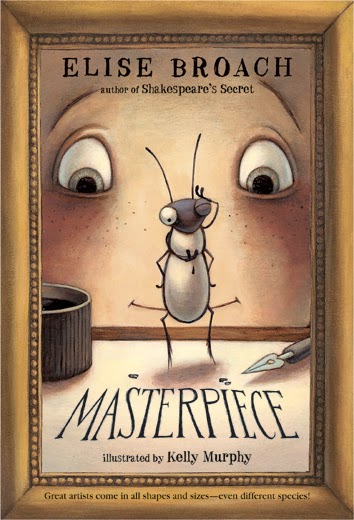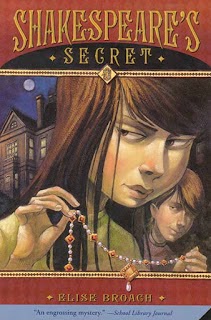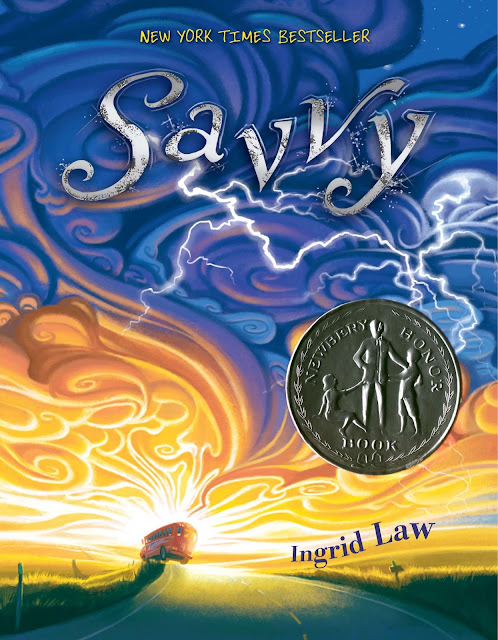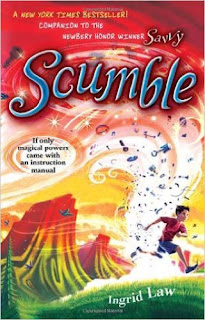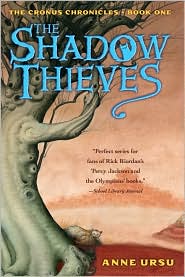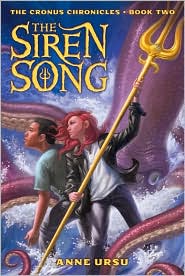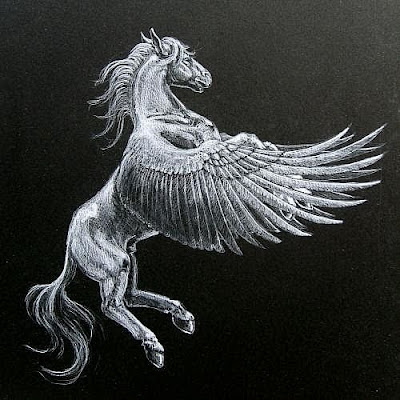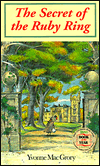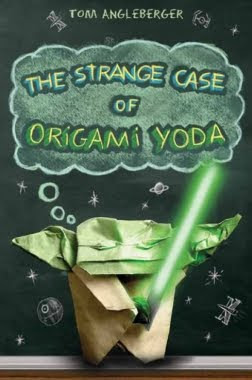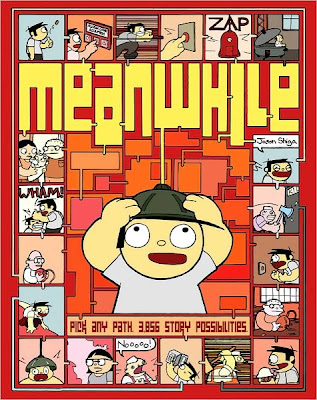MASTERPIECE is now in PAPERBACK!!!
This is such a fabulous book, and a great read-out-loud for the 5 and under crowd who are ready for a more complex story that is still gentle and only a little suspenseful...
In the great tradition of EL Konigsburg's masterpiece of children's literature, From the Mixed-up Files of Mrs Basil E Frankweiler, with a little Cricket in Times Square thrown in, comes Elise Broach's fantastic new mystery, Masterpiece, with superb illustrations by the wonderful Kelly Murphy, doing double duty as the illustrator of the text and the artist behind the creations of Marvin, the beetle with a true artistic gift.
Masterpiece involves drawings by the great German artist Albrecht Durer, art theft, forgery, the FBI and beetles, not necessarily in that order. Marvin is a beetle living the good life in the walls of the Pompaday aprtment in New York City. He has loving and attentive parents, a large extended family and William Pompaday, an unruly baby who drops plentiful (for beetles) amounts of food on the floor of the kitchen. When we first meet Marvin, he is being awakened from a deep slumber to come to the aid of his family and Mrs Pompaday, who has dropped a contact lens down the drain of the bathroom sink. Like the Borrowers and The Littles, the beetles repay the food and objects they take from the humans by performing helpful tasks around the apartment, such as repairing small appliances and helping locate lost items. This is an act of self-preservation as well, as it keeps electricians, plumbers and the likes from poking about and possibly uncovering the beetles' homes, ensuring the next visitor to the apartment would be the exterminator. Marvin takes his peanut-shell-floatie and gamely hops down the drain and retrieves the contact lens, which is deposited in a not too obvious spot after being excavated from the drain pipe.
Marvin is a cautious, thoughtful and observant beetle who, despite the insistence of his parents otherwise, believes that humans can be friends with bugs based on the time he has spent watching James, Mrs Pompaday's son from a previous marriage to the abstract painter, Karl Terik. Mrs Pompaday takes her career as a relator a little too seriously and is always mixing business with pleasure. James' eleventh birthday party, brilliantly described as a "boisterous disaster" by Broach, takes place shortly after the contact lens incident and is attended by the children of Mrs Pompaday's clients, or people she would like to be clients and none of James' friends, if he in fact has any. The disappointing afternoon is topped off with a visit from James' father and the gift of a pen and ink set that his mother feels will result in a horrible mess for sure. Dispiritedly, James makes a few experimental scribbles and writes his name with the pen then goes to bed, leaving the bottle of ink open. When Marvin goes to James' room that night to deliver his birthday present, he sees the ink and is overcome by the desire to try drawing with it. He dips his arms into the ink and produces a remarkable miniature sketch of the scene outside James' window. And this is where the story really takes off!
James discovers Marvin and his picture in the morning and is delighted. But, he is even more taken with Marvin himself. Amid the excitement of his parents over what is perceived to be James' drawing and his newly uncovered artistic potential, James and Marvin forge a friendship and a form of communication (Marvin cannot talk, to James anyway) that allows them to get along pretty well, despite several life threatening situations for Marvin and many nights passed without his parents knowing where he is, if he is alive or dead. In one of many climactic scenes in Masterpiece, Marvin is faced with the choice of letting his friend down or disobeying his mother, who is standing right next to him. Like Lynne Jonell's enthralling Emmy and the Incredible Shrinking Rat, Broach goes back and forth between the insect/rodent world and the human world, bringing up important issues to be resolved in each, and making important points about choices, actions and decisions in each as well. Broach sprinkles her story with important observations about the nature of life, beauty and art throughout. The imaginary Virtue drawings by Durer are representations of Fortitude, Justice, Temperance and Prudence, and being an important part of the story, they get discussed somewhat philosophically throughout Masterpiece, with Plutarch and Nietzsche's names even being bandied about. But one of my favorite lines in Masterpiece is spoken by Marvin's mother who, when asked by Marvin why beetles don't get divorced after he has been pondering feelings that James shared with him about his parent's divorce answers, "Well, our lives are so short, darling. What would be the point? We have so little time, we must spend it as happily as possible...And we expect a lot less than people do. If we get through a day without being stepped on, with a little food to fill our bellies, a safe place to bed down for a few hours, and ou family and friends close by - well, that's a good day, isn't it?" Simple as it is, I feel like I would do well to adopt a more beetle-ish outlook on my own life...
As I said, there is a mystery in this book that involes James posing as the artist of a forged Durer to be used as bait for an art thief. Beyond that, I can't say much more without giving away too many surprises. And there are surprises. I gasped out loud at one point and couldn't stop reading until I finished the book after that point. Broach does a masterful job of weaving many fascinating elements into her superb story.
Don't miss these other fantastic books by Elise Broach!
one of the best picture books of 2008, and all time, really...
a fantastic and rare mystery for middle schools, and one that involves Shakespeare!
And don't miss the Superstition Mountain Trilogy, of which the first two books have been published:
Source: Purchased
